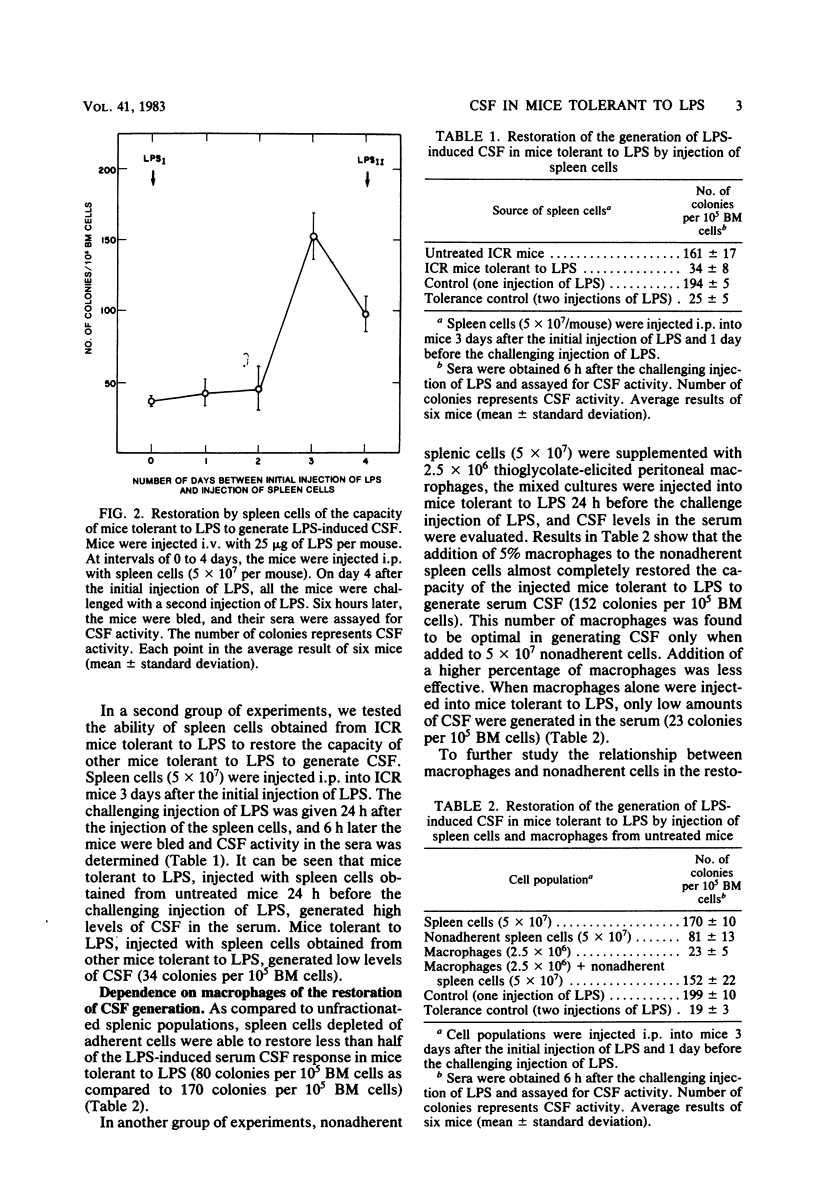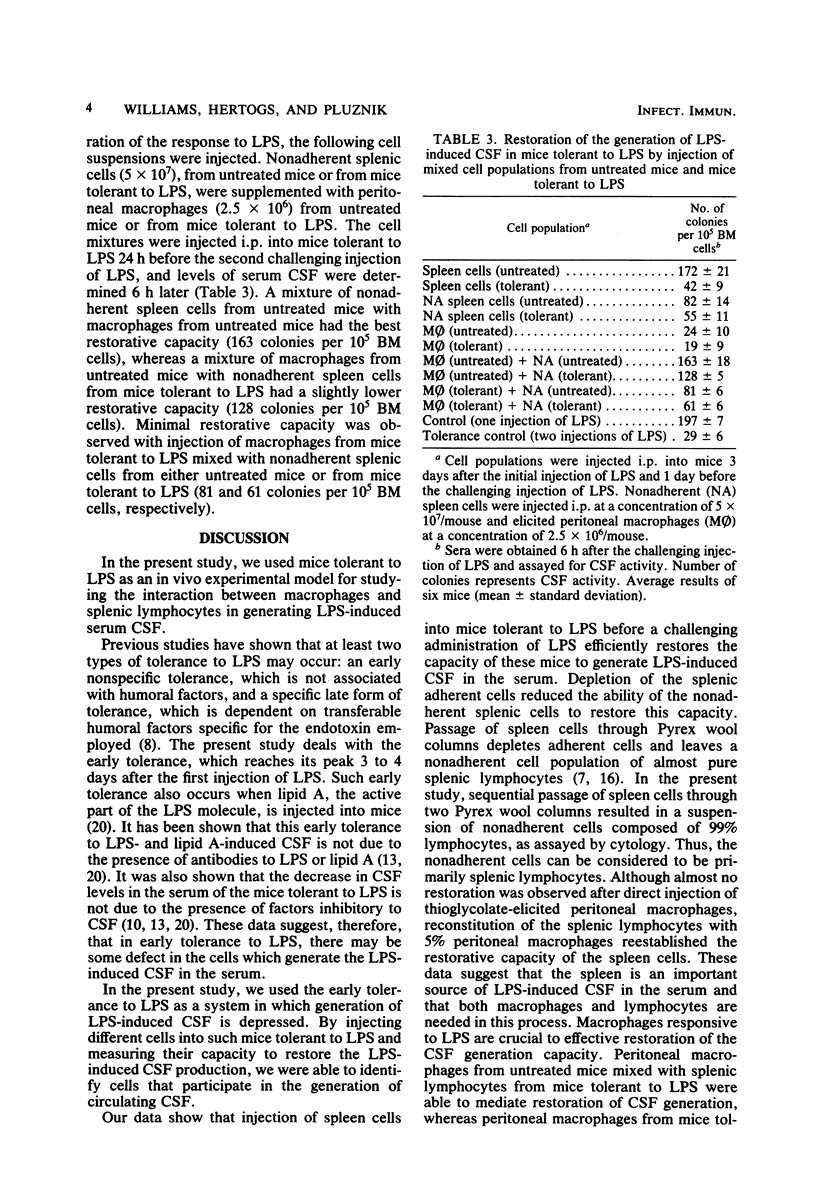Abstract
Injection of lipopolysaccharide (LPS) into mice was followed by a rapid elevation of colony-stimulating factor (CSF) in the serum. A second, challenging injection of LPS given 3 to 4 days later failed to induce elevated levels of CSF in the serum. Such mice tolerant to LPS were used as an experimental tool to identify the CSF-producing cells which respond to LPS. We observed that generation of LPS-induced CSF in mice tolerant to LPS could be restored by an intraperitoneal injection of spleen cells 24 h before the challenging injection of LPS. Depletion of the adherent cells from the spleen cells reduced the ability of the splenic lymphocytes to restore the capacity of the mice tolerant to LPS to generate serum CSF. Reconstitution of the splenic lymphocytes with 5% thioglycolate-elicited peritoneal macrophages, however, reestablished the restorative capacity of these cells, whereas almost no restoration was observed after direct injection of elicited peritoneal macrophages. These data suggest that the spleen cells are active in generating CSF, provided that macrophages are present and can interact with the splenic lymphocytes to generate LPS-induced CSF in the serum.
Full text
PDF




Selected References
These references are in PubMed. This may not be the complete list of references from this article.
- Apte R. N., Galanos C., Pluznik D. H. Lipid A, the active part of bacterial endotoxins in inducing serum colony stimulating activity and proliferation of splenic granulocyte/macrophage progenitor cells. J Cell Physiol. 1976 Jan;87(1):71–78. doi: 10.1002/jcp.1040870110. [DOI] [PubMed] [Google Scholar]
- Apte R. N., Hertogs C. F., Pluznik D. H. Generation of colony-stimulating factor by purified macrophages and lymphocytes. J Reticuloendothel Soc. 1979 Nov;26(5):491–500. [PubMed] [Google Scholar]
- Apte R. N., Hertogs C. F., Pluznik D. H. Regulation of lipopolysaccharide-induced granulopoiesis and macrophage formation by spleen cells. II. Macrophage-lymphocyte interactions in the process of generation of colony-stimulating factor. J Immunol. 1980 Mar;124(3):1223–1229. [PubMed] [Google Scholar]
- Apte R. N., Pluznik D. H. Control mechanisms of endotoxin and particulate material stimulation of hemopoietic colony forming cell differentiation. Exp Hematol. 1976 Jan;4(1):10–18. [PubMed] [Google Scholar]
- Cline M. J., Rothman B., Golde D. W. Effect of endotoxin on the production of colony-stimulating factor by human monocytes and macrophages. J Cell Physiol. 1974 Oct;84(2):193–196. doi: 10.1002/jcp.1040840205. [DOI] [PubMed] [Google Scholar]
- Eaves A. C., Bruce W. R. In vitro production of colony-stimulating activity. I. Exposure of mouse peritoneal cells to endotoxin. Cell Tissue Kinet. 1974 Jan;7(1):19–30. doi: 10.1111/j.1365-2184.1974.tb00395.x. [DOI] [PubMed] [Google Scholar]
- Greisman S. E., Young E. J., Carozza F. A., Jr Mechanisms of endotoxin tolerance. V. Specificity of the early and late phases of pyrogenic tolerance. J Immunol. 1969 Dec;103(6):1223–1236. [PubMed] [Google Scholar]
- Metcalf D. Acute antigen-induced elevation of serum colony stimulating factor (CFS) levels. Immunology. 1971 Sep;21(3):427–436. [PMC free article] [PubMed] [Google Scholar]
- Metcalf D. Depressed responses of the granulocyte-macrophage system to bacterial antigens following preimmunization. Immunology. 1974 Jun;26(6):1115–1125. [PMC free article] [PubMed] [Google Scholar]
- Morrison D. C., Ryan J. L. Bacterial endotoxins and host immune responses. Adv Immunol. 1979;28:293–450. doi: 10.1016/s0065-2776(08)60802-0. [DOI] [PubMed] [Google Scholar]
- Pluznik D. H., Sachs L. The cloning of normal "mast" cells in tissue culture. J Cell Physiol. 1965 Dec;66(3):319–324. doi: 10.1002/jcp.1030660309. [DOI] [PubMed] [Google Scholar]
- Quesenberry P., Halperin J., Ryan M., Stohlman F., Jr Tolerance to the granulocyte-releasing and colony-stimulating factor elevating effects of endotoxin. Blood. 1975 Jun;45(6):789–800. [PubMed] [Google Scholar]
- Quesenberry P., Morley A., Stohlman F., Jr, Rickard K., Howard D., Smith M. Effect of endotoxin on granulopoiesis and colony-stimulating factor. N Engl J Med. 1972 Feb 3;286(5):227–232. doi: 10.1056/NEJM197202032860502. [DOI] [PubMed] [Google Scholar]
- Ruscetti F. W., Chervenick P. A. Regulation of the release of colony-stimulating activity from mitogen-stimulated lymphocytes. J Immunol. 1975 May;114(5):1513–1517. [PubMed] [Google Scholar]
- Ruscetti F. W., Chervenick P. A. Release of colony-stimulating factor from monocytes by endotoxin and polyinosinic-polycytidylic acid. J Lab Clin Med. 1974 Jan;83(1):64–72. [PubMed] [Google Scholar]
- Sheridan J. W., Metcalf D. A low molecular weight factor in lung-conditioned medium stimulating granulocyte and monocyte colony formation in vitro. J Cell Physiol. 1973 Feb;81(1):11–23. doi: 10.1002/jcp.1040810103. [DOI] [PubMed] [Google Scholar]
- Sheridan J. W., Metcalf D. Studies on the bone marrow colony stimulating factor (CSF): relation of tissue CSF to serum CSF. J Cell Physiol. 1972 Aug;80(1):129–140. doi: 10.1002/jcp.1040800114. [DOI] [PubMed] [Google Scholar]
- Sheridan J. W., Stanley E. R. Tissue sources of bone marrow colony stimulating factor. J Cell Physiol. 1971 Dec;78(3):451–460. doi: 10.1002/jcp.1040780314. [DOI] [PubMed] [Google Scholar]
- Staber F. G. Diminished response of granulocyte-macrophage colony-stimulating factor (GM-CSF) in mice after sensitisation with bacterial cell-wall components. Exp Hematol. 1980 Jan;8(1):120–133. [PubMed] [Google Scholar]


